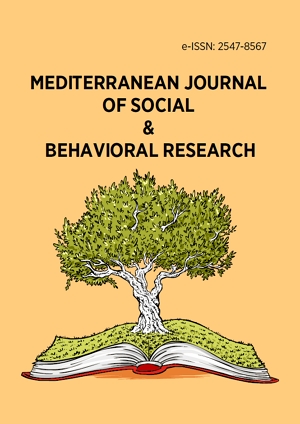Research Article
Do gender and age jointly or individually moderate the effects of cognitive and behavioral therapies on addiction to mobile phone calling behavior?
More Detail
1 College of Education, University of Cape Coast, Cape Coast, GHANA* Corresponding Author
Mediterranean Journal of Social & Behavioral Research, 7(1), February 2023, 15-18, https://doi.org/10.30935/mjosbr/12583
Submitted: 03 August 2022, Published Online: 27 October 2022, Published: 01 January 2023
OPEN ACCESS 944 Views 734 Downloads
ABSTRACT
Mobile phone technology has gradually become a part of higher educational experience, and almost every member of the university community uses or owns a mobile phone to communicate with others. Despite the many benefits that mobile phone accrues, the excessive use of them has resulted in the problem of mobile addiction. This study examined the effects of cognitive therapy and behavioral therapy in dealing with mobile phone addiction among students. The study employed the quasi-experimental (non-equivalent) research design, with a pre-test-post-test control group. Using the stratified sampling technique, sixty participants were selected for the study. An adapted test of mobile phone dependence with McDonald’s omega coefficient reliability estimates of .82 was used for data collection for both the pre- and post-test. The hypotheses were tested using a three-way analysis of covariance. Evidence from this study was that, neither cognitive therapy nor behavioral therapy was efficacious in reducing addiction to mobile phone calls among university students. It was also found that neither gender nor age moderated the effects of cognitive therapy and behavioral therapy. It was recommended that counsellors should consider other psychological therapies to reduce mobile phone call addiction.
CITATION (APA)
Edjah, J. O., & Nkrumah, I. K. (2023). Do gender and age jointly or individually moderate the effects of cognitive and behavioral therapies on addiction to mobile phone calling behavior?. Mediterranean Journal of Social & Behavioral Research, 7(1), 15-18. https://doi.org/10.30935/mjosbr/12583
REFERENCES
- Beal, V. (2010). The difference between a cell phone, smartphone, and PDA. http://www.webopedia.com/DidYouKnow/Hardware_S
- Bratter, T. E., & Forest, G. G. (1985). Alcoholism and substance abuse: Strategies for clinical intervention. The Free Press.
- Brian, S. J. (2013). Two days with no phone. Scholastic Action, 37, 4-6.
- Choliz, M. (2012). Mobile phone addiction in adolescence: The test of mobile phone dependence (TMD). Progress in Health Science, 2(1), 33-44.
- Edjah, J. O., & Ankomah, F. (2020). Influence of gender and marital status on mobile phone addictive behaviors of students exposed to cognitive and behavioral therapies. The International Journal of Humanities and Social Studies, 8(11), 58-64. https://doi.org/10.24940/theijhss/2020/v8/i11/HS2011-021
- Eto, D. (2012). Over 24 million mobile phone subscribers in Ghana. http://www.Itnewsafrica.com
- Griffiths, M. (2000). Does internet and computer “addiction” exist? Some case study evidence. Cyber Psychology and Behavior, 3, 211-218. https://doi.org/10.1089/109493100316067
- Griffiths, M. D. (2005). A components model of addiction within a bio-psychosocial framework. Journal of Substance Use, 10, 191-197. https://doi.org/10.1080/14659890500114359
- Hofmann, S., Asaani, A., Vonk, I., Sawyer, A., & Fang, A. (2012). The efficacy of cognitive behavioral therapy: A review of meta-analyses. Cognitive Therapy Research, 36, 427-440. https://doi.org/10.1007/s10608-012-9476-1
- James, D., & Drennan, J. (2005). Exploring addictive consumption of mobile phone technology. http://smib.vuw.ac.nz:8081/anzma2005/
- Kalba, K. (2008). The adoption of mobile phones in emerging markets: Global diffusion and the rural challenge. International Journal of Communication, 2, 631-661.
- Lee, Y. K., Chang, C. T., Lin, Y., & Cheng, Z. H. (2014). The dark side of smartphone usage: Psychological traits, compulsive behavior, and technostress. Computers in Human Behavior, 31, 373-383. https://doi.org/10.1016/j.chb.2013.10.047
- Leedy, P. D., & Ormod, J. E. (2010). Practical research: Planning and design. Pearson.
- Leung, L. (2008). Linking psychological attributes to addiction and improper use of the mobile phone among adolescents in Hong Kong. Journal of Children and Media, 2(2), 93-113. https://doi.org/10.1080/17482790802078565
- Maguire, M., & Osman, Z. (2003). Designing for older inexperienced mobile phone users. In Proceedings of HCI International. Lawrence Erlbaum Associates.
- Malak, M. Z. (2018). Internet addiction and cognitive behavioral therapy. In O. Senormanci, & G. Senormanci (Eds.), Cognitive behavioral therapy and clinical applications (pp. 183-199). IntechOpen. https://doi.org/10.5772/intechopen.71277
- Matusik, S. F., & Mickel, A. E. (2011). Embracing or embattled by converged mobile device? Users’ experiences with a contemporary connectivity technology. Human Relations, 64(8), 1001-1030. https://doi.org/10.1177/0018726711405552
- National Communication Authority. (2013). Mobile data subscription. http://www.nca.org.gh/73/34/News.html
- Oulasvirta, A., Rattenbury, T., Ma, L., & Raita, E. (2012). Habits make smartphone use more pervasive. Personal and Ubiquitous Computing, 16(1), 105-114. https://doi.org/10.1007/s00779-011-0412-2
- Pituch, K. A., & Stevens, J. P. (2016). Applied multivariate statistics for the social sciences: Analysis with SAS and IBM’s SPSS. Routledge. https://doi.org/10.4324/9781315814919
- Rizeanu, S. (2018). Cognitive-behavioral therapy for gambling addiction. In O. Senormanci, & G. Senormanci (Eds.), Cognitive behavioral therapy and clinical applications (pp. 161-181). IntechOpen. https://doi.org/10.5772/intechopen.72671
- SecurEnvoy. (2012). 66% of the population suffer from nomophobia the fear of being without their phones. https://www.securenvoy.com
- Shepherd, L. (2010). Cognitive behavior therapy for sexually addictive behavior. Clinical Case Studies, 9(1), 18-27. https://doi.org/10.1177/1534650109348582
- Teo, T. S. H., & Pok, S. H. (2003). Adoption of WAP-enabled mobile phones among internet users. Omega, 31(6), 483-498. https://doi.org/10.1016/j.omega.2003.08.005
- van Deursen, A., Bolle, C. L., Hegner, S. M., & Kommers, P. (2015). Modeling habitual and addictive smartphone behavior: The role of smartphone usage types, emotional intelligence, social stress, self-regulation, age, and gender. Computers in Human Behavior, 45, 411-420. https://doi.org/10.1016/j.chb.2014.12.039

 The articles published in this journal are licensed under the CC-BY Creative Commons Attribution International License.
The articles published in this journal are licensed under the CC-BY Creative Commons Attribution International License.